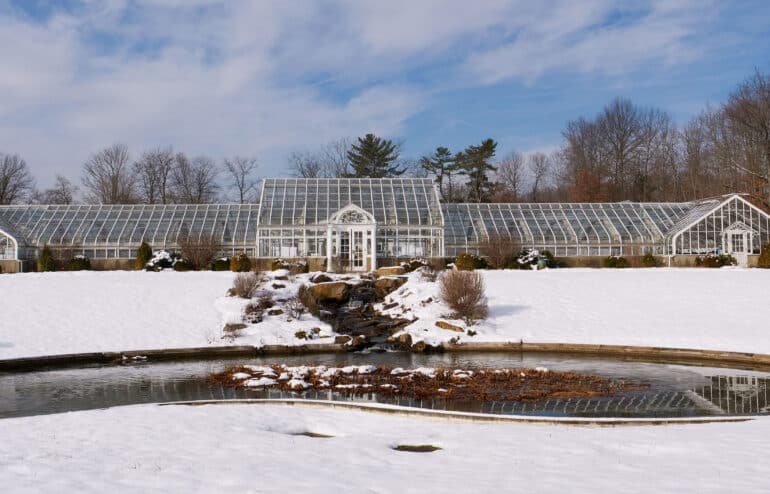
Around Greenacres - Winter 2023
Improving Garden Production with Caterpillar Tunnels
Our garden team is excited to have nine operational caterpillar tunnels. These plastic tunnels are designed to extend our growth and harvest season by protecting crops from wind and weather. Our Manager of Garden Operations, Ian Zeglin tells us that, “these tunnels allow us to get our crops outside earlier in the spring and to keep our crops longer in the ground throughout fall.”
In the winter, the tunnels provide protection from the wind and cold-weather elements. Although we have several varieties of cold-hardy crops that are able to survive Ohio winters, the tunnels allow these plants to thrive in a harvestable manner. In the summer, the tunnels are then used for warm weather crops such as tomatoes and peppers. These crops love heat and the tunnels help provide a warm environment in which they can thrive. The tunnels also help keep leaves dry so that we don’t get diseases like late blight. Ian Zeglin also mentions that “with their light-weight and compact design, these tunnels can easily be moved and utilized all over the farm!”.
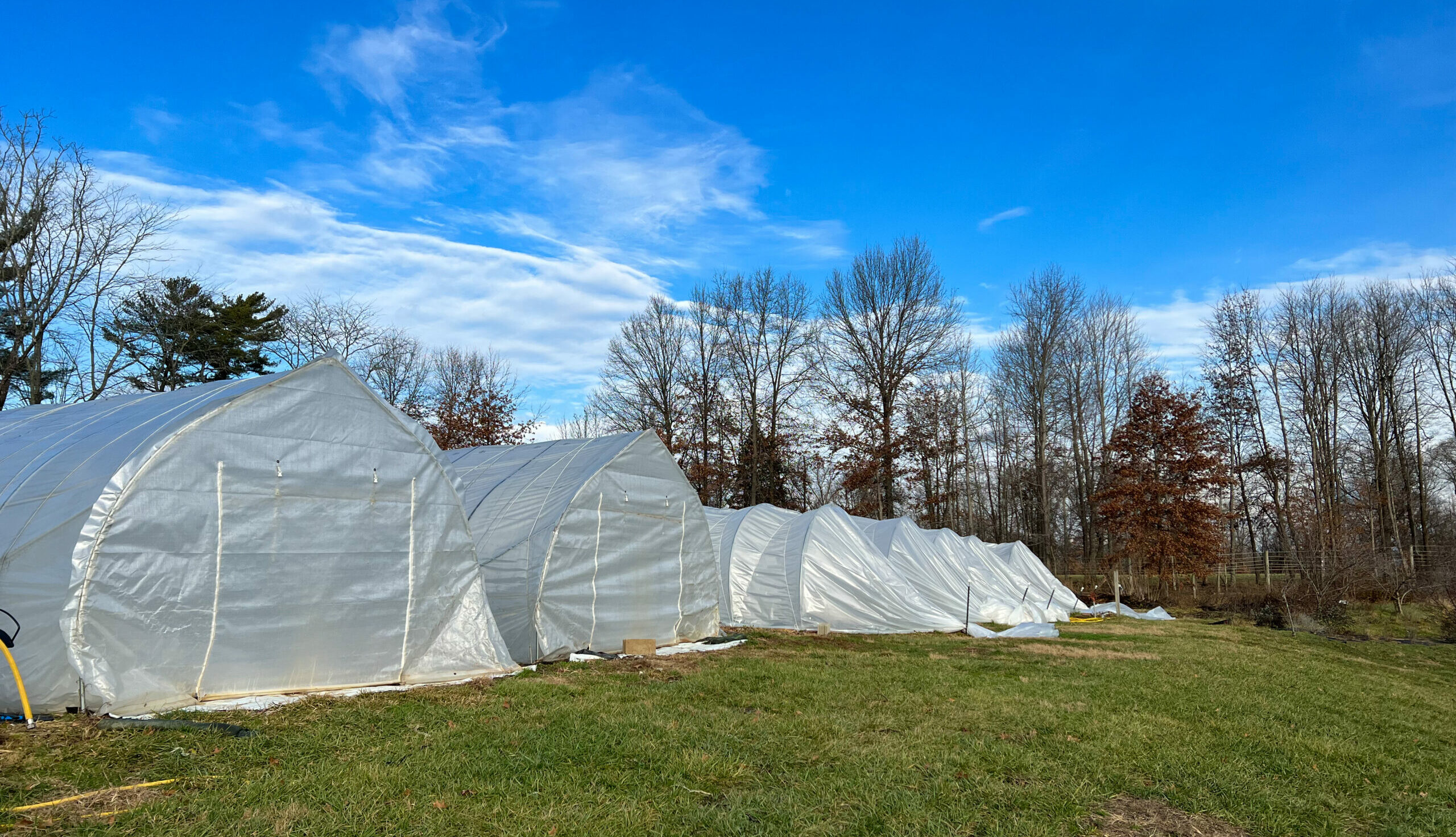
“These tunnels allow us to get our crops outside earlier in the spring and to keep our crops longer in the ground throughout fall. And, with their light-weight and compact design, these tunnels can easily be moved and utilized all over the farm!”
-Ian Zeglin, Manager of Garden Operations
What's New at Michaela Farm?
Indian Hill isn’t the only campus with new high tunnels. Our garden crew at Michaela Farm is also adding them to the St. Mary’s Road gardens. In addition to vegetable production improvements, we are gradually reintroducing more livestock back to the farm. Last month, we added a mobile coop to the property, along with a flock of 150 laying hens and two roosters which means eggs have returned to the store! Mobile coops benefit the pasture as the manure fertilizes the ground and the chickens eat insects and break up the soil with their scratching. You can click here to see a video tour of the coops we use and learn more about our egg production practices.
“We are looking forward to more vegetables year round at Greenacres Michaela Farm!“
-Jules Brookbank, Garden Site Supervisor
Turning Geography into Data
Geographic information systems (GIS) is a way to combine data and maps to reveal new insights. The research department recently begun using GIS to broaden its capabilities through experiment site planning, mobile data collection, and data modeling. “Maps and GIS allow us to quickly get a snapshot of the land, using a combination of field-collected and remotely-sensed data. With a better understanding of our properties, our researchers and land managers can more effectively achieve their goals,” says Research Assistant, Luke Weyer.
One use of GIS is the detection of Amur honeysuckle via satellite. Amur honeysuckle and other invasive shrubs were removed at Greenacres starting in 2017. Amur honeysuckle maintains a competitive advantage over native plants by keeping green leaves and photosynthesizing after most native trees/shrubs have lost their leaves. Because of this, satellite imagery from November can “see through” the bare canopy and distinguish green honeysuckle leaves from the surrounding dormant vegetation.
As with all models, the data presented by GIS should not be immediately accepted as fact; there will be sources of error. These maps can, however, be used as a starting point to notice broad patterns (like the overall success of the removal), indicate areas on property where honeysuckle presence needs to be confirmed/rejected, and identify where honeysuckle is most likely to re-enter the property.
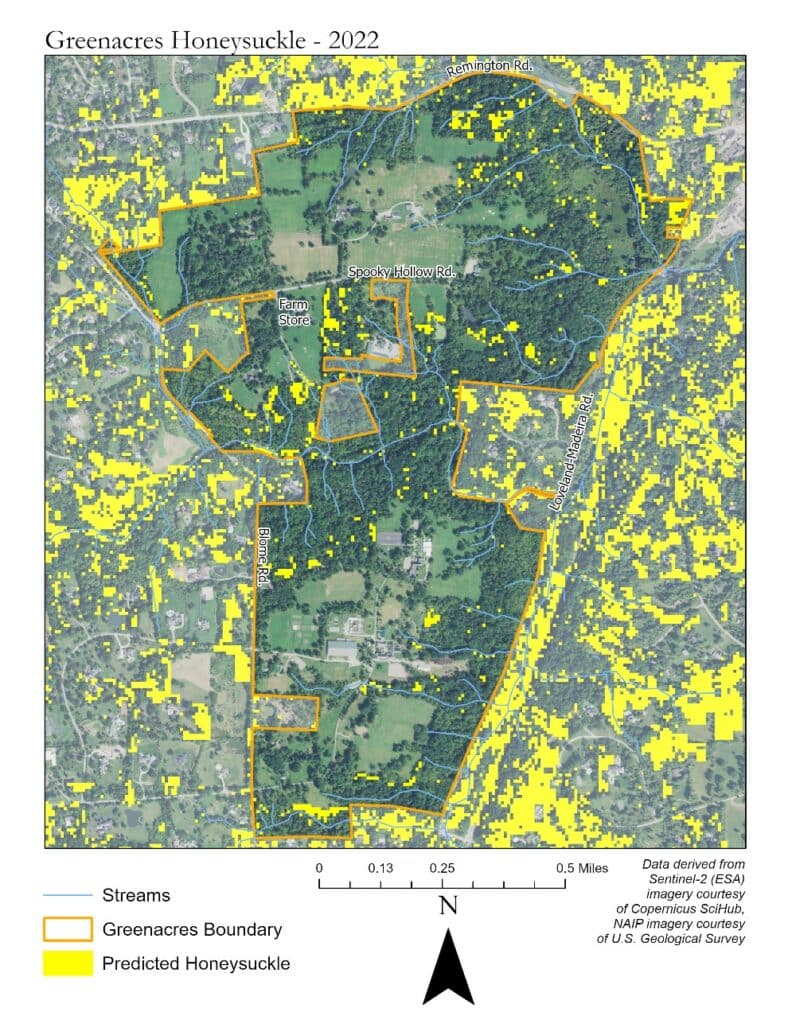
“Maps and GIS allow us to get quickly get a snapshot of the land, using a combination of field-collected and remotely-sensed data. With a better understanding of our properties, our researchers and land managers can more effectively achieve their goals.”
-Luke Weyer, Research Assistant
Electric Lawn Mowers
After a year long trial of electric automatic lawn mowers, Greenacres has purchased an additional six. These electric mowers are quieter, safer, and require less maintenance than traditional lawn mowers, making them a great fit for our “green” initiatives. Our goal is that they outlive our older-model lawn equipment to prove their sustainability. Our Buildings and Grounds Director, Alex Saurber informs us, “after several months of research, we are very excited to move forward with the additional automatic mowers. With these new mowers at work, it frees up a lot of time for our estate crew to start new projects, including ‘green’ ones. We are proud to be taking steps towards a greener future and look forward to reduced emissions when maintaining our lawns.”
“After several months of research, we are very excited to move forward with the additional automatic mowers. With these new mowers at work, it frees up a lot of time for our estate crew to start new projects, including ‘green’ ones. We are proud to be taking steps towards a greener future and look forward to reduced emissions when maintaining our lawns.”
-Alex Saurber, Director of Buildings and Grounds
Maple Syrup Production at Greenacres
Did you know North America is the only place in the world where maple syrup is produced? In fact, the majority of maple syrup comes from Canada. However, there are twelve maple-producing states in the US, and Ohio is ranked in the Top Five. In southern Ohio, sap begins to flow in late January or early February. The best production happens when the temperatures reach over 40F during the day and below 32F during the nights.
We tap sugar maple trees as this species has the highest sugar content of all maple species. It requires over 40 gallons of sap to produce 1 gallon of pure maple syrup! Each maple season, students visit Greenacres to experience the entire maple syrup process through our field trip programming. This year we shared the joy of maple syrup production in our new Sugar Shack at our Old Church site. This is where we begin the process of evaporating and producing maple syrup from the sap we collected in our “sugar bush.”
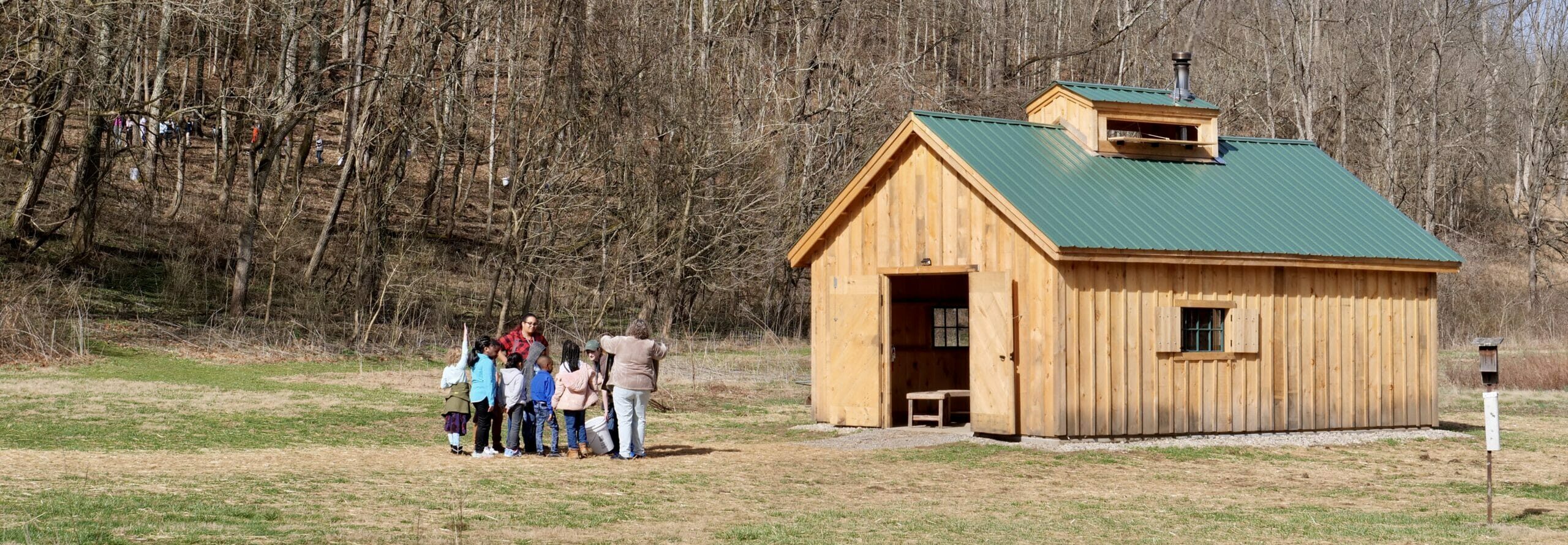
Preserving Herbs Through Dehydration
Dried herbs are a great way to add flavor to your cooking, especially when fresh options are not available. Drying preserves the flavor of the herbs, reducing waste and maximizing the yield of our plants during the growing season. We were able to introduce these to our customers thanks to the efforts of our Garden Apprentice, Abby McGuire. Garden apprentices are required to select a project for personal development and Abby selected dried herb production. We’re very proud of what she accomplished!
We grow a vareity of herbs, like sage, thyme, lavender and chamomile. The plants are packed with oils and flavors and are harvested by the garden team early in the day alongside our vegetables. Post-harvest care varies based on the characteristics of each herb. Some herbs like sage and rosemary benefit from the leaves being removed from the stem before drying, while thyme is small and tender, better suited to dry with the leaves on the stem, and then stripped after drying.
We worked with the Health Department to develop kitchen protocols to ensure food safe practices are followed during the dehydration and packaging process. It can take anywhere from 8-12 hours to create a finished product depending on the variety of the herb being dehydrated. Herbs that are woody, like rosemary, take longer to dry fully than delicate herbs like basil and dill. Once dry, the herbs are carefully weighed and packaged into individual packets, heat sealed, and labeled. We are excited to bring these little glimpses of summertime freshness into the Farm Store!
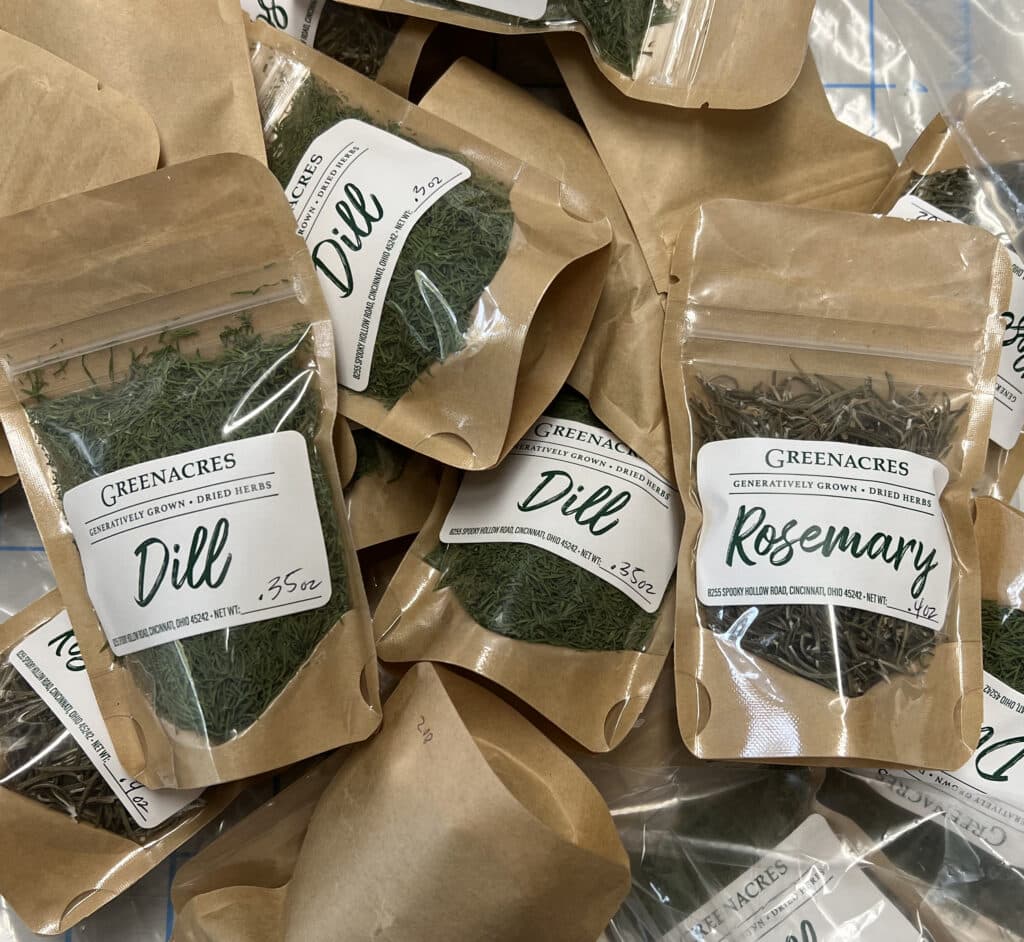
“We want to ensure our plants are healthy before we harvest, to guarantee a quality product and allow the plant to regenerate for the future.”
Abby McGuire, Garden Apprentice
Winter Equine Program
The 2023 Spring Session is full. We still have an active waitlist, so if you are interested in enrolling your children in the lesson program we invite you to join our waitlist. We enroll riders between the ages of 8-18.
School Horse Spotlight
Sol is a 24 year old warmblood and has been a Greenacres school horse since 2012. Sol is a jack of all trades in our lesson program. He is quiet enough to teach the beginners how to walk and trot, but he can also teach riders how to jump. During show season, Sol enjoys traveling to horse shows with our Pony Club members. When Sol is not teaching lessons or traveling to horse shows, you will find him hanging out with his best friend Quest during turnout.


